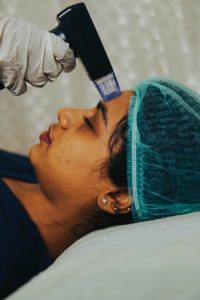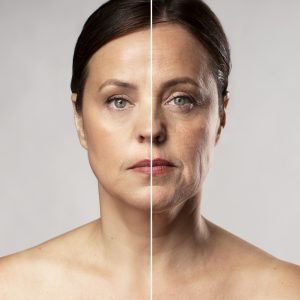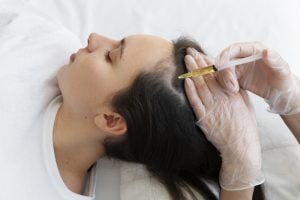This revolutionary facelift technique was designed in 1999 at the Coupure Center for Plastic Surgery by Dr. Tonnard & Dr. Verpaele to perform the lifting of the aged face in a simple, natural way and with minimal burden and risk for the patient. I was trained directly by them in this pioneering face-lift technique.
MACS lift stands for Minimal Access Cranial Suspension lift, i.e., a facelift via a short scar and vertical suspension of the sagging tissues.
The main advantages of the MACS lift are:
- natural results while maintaining your own facial features
- safer by avoiding classical facelift complications
- a shorter inconspicuous scar
- a smoother recovery
- a long lasting result
In summary, with the MACS lift, a limited area of skin is released through a small incision along the front edge of the ear and the stretched facial tissues are brought back to their original position in the vertical direction. To this end, two firm yet digestible threads are woven into the fabrics so that a durable vertical lifting is achieved. Herein lies the secret of the invisible scars: all tension is subcutaneous, the skin itself is hardly drawn. This causes the sagging neck, chin and cheeks to be corrected and only a small amount of skin is removed.
The MACS lift avoids the so-called “wind tunnel effect”, caused by too much traction to the rear, which is unfortunately too often seen with classic facelifts.
The MACS-lift can be performed on its own or often supplemented by other techniques such as a liposculpture of the double chin, a lipofilling, an upper and/or lower eyelid correction, a brow lift or a lip lift. Each candidate for such surgery is personally analyzed and no two operations are exactly the same. We rely on your photographs between the ages of 20 and 30 to achieve the most natural rejuvenation of the face.
The Current Philosophy
“Centrofacial Rejuvenation” is a new concept which combines different techniques to rejuvenate the central part of the face, i.e., around the eyelids and mouth. The strength of this lies in the fact that the eyes and mouth are the sources of dynamic emotional expression of the face. When one succeeds in rejuvenating these areas employing various surgical/non-surgical techniques, one is able to recreate desirable results.
FACELIFT: Everything you ever wanted to know
What does a facelift correct:
A facelift, or rhytidectomy, is a surgical procedure that improves visible signs of aging in the face and neck, such as:• Relaxation of the skin of the face causing sagging• Deepening of the fold lines between the nose and corner of the mouth• Fat that has fallen or has disappeared• Jowls developing in the cheeks and jaw• Loose skin and excess fat of the neck that can appear as a double chin or “turkey neck”
What facelift surgery can’t do:
As a restorative surgery, a facelift does not change your fundamental appearance and cannot stop the aging process.
A facelift can only be performed surgically; minimally invasive rejuvenation treatments cannot achieve the same results, but may help delay the time at which a facelift becomes appropriate and complement the results of surgery.
Some minimally invasive treatments, such as stem cell facelifts, are of unproven benefit.
What should I expect during a consultation for a facelift?
During your facelift consultation be prepared to discuss:• Your surgical goals• Medical conditions, drug allergies and medical treatments• Current medications, vitamins, herbal supplements, alcohol, tobacco and drug use• Previous surgeries
Your surgeon will also:• Evaluate your general health status and any pre-existing health conditions or risk factors• Discuss your facelift options• Examine and measure your face• Take photographs• Recommend a course of treatment• Discuss likely outcomes of a facelift and any risks or potential complications• Discuss the type of anaesthesia that will be used
What questions should I ask my plastic surgeon about facelift surgery? (FAQs)
A checklist for your facelift consultation:• Are you a certified plastic surgeon?• Were you specifically trained in the field of plastic surgery?• How many years of plastic surgery training have you had?• Am I a good candidate for this procedure?• What will be expected of me to get the best results?• Where and how will you perform my procedure?• What surgical technique is recommended for me?• How long of a recovery period can I expect, and what kind of help will I need during my recovery?• What are the risks and complications associated with a facelift?• How are complications handled?• How can I expect my face to look over time?• What are my options if I am dissatisfied with the cosmetic outcome of my facelift?• Do you have before-and-after photos I can look at for this procedure and what results are reasonable for me?
You are a good candidate for Facelift, if…• You are in your 40’s – 70’s and have a haggard look• Healthy, without any medical condition which could impair healing• Condition of your skin is good• You have facial imperfections caused by excess sagging tissue and/or sagging skin• You have sagging cheeks & deep visible lines around the nose• You have a positive outlook and realistic expectations• Non-smoker
Procedure description in short including common essential steps, types of anesthesia, etc.
A facelift procedure includes the following steps:
Step 1 – Anaesthesia
Medications are administered for your comfort during the surgical procedure. The choices include intravenous sedation and general anesthesia. Your doctor will recommend the best choice for you.
A variety of other procedures can further enhance the outcome of a facelift. They include:• Facial implants or fat transfer to improve the contour• Resurfacing techniques to improve the tone and texture of facial skin• Wrinkle reduction by injection of fat or fillers
Step 2 – The incision
Depending on the degree of change you’d like to see, your facelift choices include a traditional facelift, limited incision/short scar facelift and/or a neck lift.
Traditional Facelift:
A traditional facelift incision often begins in the hairline at the temples, continues around the ear and ends in the lower scalp. Fat may be sculpted or redistributed from the face, jowls and neck and underlying tissue is repositioned, commonly the deeper layers of the face and the muscles are also lifted. Skin is redraped over the uplifted contours and excess skin is trimmed away.
A second incision under the chin may be necessary to further improve an aging neck. Sutures (absorbable or non-absorbable) or skin adhesives close the incisions.
Limited Incision/short scar/mini facelift:
An alternative to a traditional facelift uses shorter incisions at the temples, continuing around the ear. “Mini-lifts” are usually reserved for patients with less skin relaxation, as the results are less rejuvenating than a full facelift.
Neck Lift:
A necklift addresses the sagging jowls, loose neck skin and fat accumulation under the chin. The neck lift incision often begins in front of the ear lobe and wraps around behind the ear, and ends in the posterior hair behind the ear.
Step 3 – Closing the incisions
The incisions will be closed with sutures that may dissolve or may need to be removed after a few days. Some surgeons use skin glues to seal the incisions. Once healed, the incision lines from a facelift are well concealed within the hairline and in the natural contours of the face and ear.
In a nutshell…
FACELIFT SURGERY – WHAT TO EXPECT
• About the Surgery – a facelift involves lifting and redraping the skin, tightening underlying facial tissues, and eliminating small pockets of fat near the chin and neck. The result is the elimination of wrinkles and a more revitalized, attractive look• Anaesthesia – local anaesthesia + intravenous sedation or general anaesthesia• Surgery Length – 2 to 4 hours• Pain Medication – is prescribed and typically used for 2 or 3 days after surgery• Post Surgery – swelling and bruising can last for 1 to 2 weeks. Sutures (stitches) are generally removed at 1 and 2 weeks. Most patients look well after 2 weeks, but the final result from facelift surgery is evaluated 6 months later. Numbness and firmness persist for months but do not affect appearance. Light exercise is permitted at 2 weeks and vigorous exercise can be resumed 4 to 6 weeks after surgery.
What are the risks of facelift surgery?
The decision to have plastic surgery is extremely personal and you will have to weigh the potential benefits in achieving your goals with the risks and potential complications of facelift surgery. Only you can make that decision for yourself. You will be asked to sign consent forms to ensure that you fully understand the procedure and any risks and potential complications.
Facelift risks, while rare, include:• Anaesthesia risks• Bleeding• Infection• Poor wound healing and skin loss• Facial nerve injury with weakness• Temporary or permanent hair loss at the incisions• Fluid accumulation• Numbness or other changes in skin sensation• Persistent pain• Unfavourable scarring• Prolonged swelling• Skin irregularities and discoloration• Sutures may spontaneously surface through the skin, become visible or produce irritation that require removal• Unsatisfactory results may include: asymmetry, unsatisfactory surgical scar location and unacceptable visible deformities at the ends of the incisions. (It may be necessary to perform an additional surgery to improve your results)• Deep vein thrombosis, cardiac and pulmonary complications
Preparing for a facelift?
In preparing for a facelift, you may be asked to:• Get lab testing or a medical evaluation• Take certain medications or adjust your current medications• Apply certain products to the facial skin preoperatively• Stop smoking• Avoid taking aspirin, anti-inflammatory drugs and herbal supplements as they can increase bleeding and bruising.
What should I expect during my facelift recovery?
Following completion of a facelift, a bandage might be placed around your face to minimize swelling and bruising. Small tubes may be present to draw off any excess blood or fluid.
You will be given specific instructions on how to care for the surgical site and drains, medications to apply or take orally, specific concerns to look for at the surgical site or in your general health and when to follow up with your plastic surgeon.
Be sure to ask your plastic surgeon specific questions about what you can expect during your recovery period.• Where will I be taken after my surgery is complete?• What medication will I be given or prescribed after surgery?• Will I have dressings/bandages after surgery?• When will they be removed?• When will the stitches be removed?• When can I wash my face and wear make-up?• When can I resume normal activity and exercise?• When can I colour my hair or get a haircut?
What results should I expect after a facelift?
While most people are presentable to the public within 10-14 days, it will take 2-3 months for the face to feel “back to normal” in terms of texture, sensibility, and loss of tightness.
Continuing daily sun protection and a healthy lifestyle will help extend the results of your facelift.
As swelling and bruising subside, the visible improvements of a facelift appear. Your final result should not only provide a more youthful and rested appearance but also help you feel more confident about yourself.
Although good results are expected, there can be no guarantee. In some situations, it may not be possible to achieve optimal results with a single surgical procedure and another surgery may be necessary.
Follow your surgeon’s instructions to ensure the success of your surgery.
Facelift Instructions:
This printout of this information could help you on how to prepare for your facelift operation and what to expect as you are healing after your operation.
Important information about preparing for your facelift operation:1. Do not take products containing aspirin, ibuprofen,Vitamin E or red wine for 2 weeks prior or for 2 weeks after your operation. Many medications contain these compounds which are known to prolong bleeding.2. Please arrange for a friend or family member to stay with you for the first 24-48 hours following your surgery.3. Be aware that you will not be able to fly for two weeks following your operation and please plan accordingly.4. You will not be able to dye your hair with products containing peroxide for 2 weeks before and for 3 weeks after the operation because of the risk of irritation. You may colour your hair with non-peroxide hair colour within a week or 2 weeks after the operation however the result will not last very long.5. In general, you will need 1-2 weeks off from work. More limited facelifts require less time off and more extensive facelifts require more time.
On the day of your operation:
Do not wear makeup, contact lenses or jewellery on the day of your operation. Do not usehairspray, gel or mousse. Please keep your valuables at home. You may bring your glasses and a pair of sun glasses for the car ride home. Wear comfortable clothing that is easy to dress in and out of. Wear a shirt that buttons down the front.
After your operation:
1. After your operation, you will wake up with a bandage on your head. There may be drainage tubes inserted at the back of the head bandage.2. The bandage on your head and the drainage tubes will be removed the morning after your operation if you stay in the hospital or within 48 hours. A lighter bandage will then be placed.3. Sleep with your head elevated on several pillows arranged in a wedge.4. For the first 48 hours, rest quietly with minimal talking or laughing. You may get up to use the bathroom or to take a light walk around the house. Exercise caution in your home and be careful with tasks such as climbing stairs when you are taking pain medications.5. Turn your head and neck stiffly and as a unit for the first two weeks after your operation, avoid flexing and extending your neck as well.6. The most common complaint after the operation is nausea, although this generally passes within 24-48 hours. It is important that you drink liquids frequently after your operation. Do not take your pain medication on an empty stomach as you may experience nausea and/or vomiting.7. Use the pain medication as prescribed when you are feeling uncomfortable.8. On the first day after your operation, you may gently wash your face by patting it with a face cloth. You can also carefully brush your teeth.9. You may shower and wash your hair 4 days after the operation.10. Do not chew hard or tough foods for the first week after the operation.11. It will be at least 2 weeks before you can begin light exercise such as: walking or using a stationary bike.12. You will be able to wear makeup 2 weeks after your operation.13. Heavy exercise and heavy lifting are not permitted for 6 weeks. Light exercise is permitted after 2-3 weeks.14. Avoid the sun for 6 weeks after your operation. You must use sunscreen with an SPF of 30 for one year after the surgery. Apply the sunscreen to your face and directly over the scars. It is recommended that you continue to use sunscreen after one year.15. You will be able to drive after two weeks. Be aware that pain medications cause drowsiness and should not be used before driving.
What to expect as you are healing:
1. You will have bruising and swelling on your face and neck that will take 2-3 weeks to subside.2. As the swelling subsides, you will feel hard areas under the skin on your face and neck. This is to be expected and will resolve in several weeks.3. Your incisions may be raised, red, and feel hard for several months, but most incisions are inconspicuous after 2-3 weeks.4. Numbness in various areas of your face, neck and ears is common and may persist for weeks or months. You must be careful using your hairdryer at this time so you do not burn your skin.5. It is normal to experience a feeling of tightness under your chin and behind your ears. Your neck may also feel stiff. The tightness and stiffness usually last several weeks.6. The final result from surgery needs to be judged 6-12 months after your operation.
Follow-up appointments:
1. You will have several follow-up appointments after your facelift operation.2. Your first follow-up appointment will be at 1 week. At this time, you will have some of your sutures removed. The sutures will be replaced by steristrips. You may shower over the steristrips and allow them to fall off on their own.3. Your second appointment will be at 2 weeks. At this time, the remaining sutures will be removed.4. Subsequent appointments will be suggested by the concerned surgeon.




